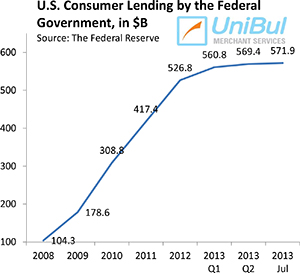Samsung Builds NFC Chips to Enable Mobile Payments in Android Phones

Just a couple of weeks after Google CEO Eric Schmidt demonstrated how the latest version of his company’s Android operating system would allow for information exchange between smart phones and merchants using near field communication (NFC) technology, one of the hardware manufacturers using Android has unveiled a new NFC chip with embedded flash memory.
NFC is a short-range high frequency wireless communication technology, which enables the exchange of data between devices over a distance about 4 inches. An NFC-enabled device can communicate with both smartcards and readers, as well as with other NFC devices.
The manufacturer in question is Samsung, a giant Korean conglomerate, whose upcoming chip may have been used in the “unannounced device” used by Schmidt during his demonstration. Samsung says that the chip has a “low power design” and that:
Samsung developed this NFC chip to have minimal power consumption in both active and stand-by mode. With a 20 percent decrease in power consumption, Samsung’s NFC chip remains active for mobile payment even without battery power.
The other innovation found in the new chip is the flash memory embedded into it. Samsung says that flash enables hardware designers to “easily to upgrade software or firmware.”
As Samsung’s release points out and others have already tested it, the new “NFC chip can play a role as a contactless smartcard in use for public transportation payments for bus and subway fares and mobile banking payments.”
This announcement comes close on the heels of the big launch last week of another NFC project. Three huge mobile carriers — AT&T, T-Mobile and Verizon — joined forces with Discover, which has the fourth-largest payment network in the U.S., and Barclays, a big British bank, to form a national mobile commerce network, called Isis.
Isis users will attach a NFC chip to their phones, which will communicate at the checkout with the merchant’s point-of-sale (POS) system. In essence, users will be making payments by waving a cell phone by a wireless device, which would “read” the user’s account information stored on the phone, much as a POS terminal does when you swipe a card through it.
Samsung’s new NFC chip will be performing the exact same functions as the one used by Isis subscribers. In fact, chances are that many Isis users will actually have the Samsung chip installed on their phones, once it is available, which is expected to happen in the first quarter of 2011.
As we have pointed out before, there is a very good reason for all this activity. The mobile payments market is expected to explode in the coming years. Many reports have been issued on the subject and we have written about a few of them.
Samsung’s release points to another interesting trend. It cites data by IMS Research, a market research firm, according to which “in 2011, NFC-enabled phone models are expected to gain pace and the ratio of mobile phones with NFC capabilities is expected to reach 26 percent in 2015.” That means a quarter of all mobile phone users in 2015 will be able to make NFC payments, and the ratio in rich countries will be much higher than that. What is even more interesting is that, according to Aite Group LLC, a research and advisory firm focused on the financial services industry, NFC payments will only rank fourth in the mobile payments list of 2015. So expect the mobile payments announcements to keep coming.
Image credit: Wikimedia Commons.



It’s been 1.5 years since this article was published and there is still only a handful of smart phones that support NFC. I would’ve hoped for faster deployment of these NFC-supporting chips.